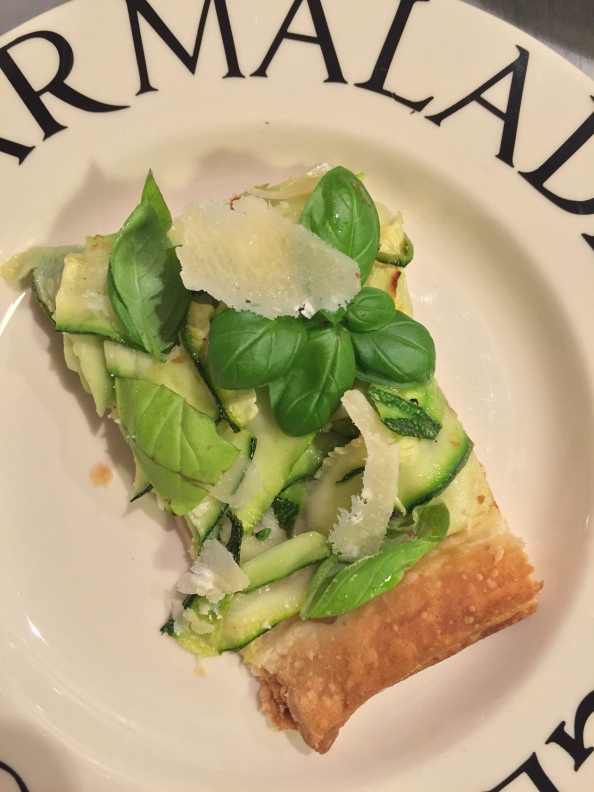French cuisine hasn’t had a great press in the last few years. I’m not sure how fair that is or how qualified I am to judge given that our last family holiday in France was 8 years ago. We were in the South West near Bordeaux, and while we were surprised to have a couple of disappointing meals we also enjoyed some sublime cuisine. Rick Stein’s recent television series “Secret France” showed that delicious French food is alive and well throughout the country and here in Bristol the fairly new restaurant Little French has been highly praised in the national press and shows that the “unpretentious French food” it offers is beloved by many of us. Following a superb lunch there the other day, during which between us my husband and I enjoyed mackerel tartare, mouclade and frites, queen scallops and hake with clams, I was inspired to make Clothilde’s Beef, a recipe in Diana Henry’s book Food from Plenty. She tells how she first ate it on a French exchange as a teenager when it was cooked by her opposite number, Clothilde. She notes that instead of potatoes, her French family served it with a gratin of macaroni. This immediately took me back to the food I used to eat on my many visits to France as a teenager and later on as a student when I was doing a degree in modern languages. It’s exactly the type of dish the mother of my friend Françoise would make. How powerfully evocative food can be!
Ingredients
- 1kg silverside of beef
- Salt and butter
- 1 tbsp groundnut oil
- 2 onions, halved and each half either sliced into crescent moons or cut into three or four wedges
- 3 garlic cloves, crushed
- 150ml dry white or red wine
- 4 carrots, halved lengthways
- 2 plum tomatoes, quartered
- 3 thyme sprigs
- 3 bay leaves
- 150ml chicken or beef stock
Method
- Season the beef
- Heat the oil in a frying pan on the boiling plate and add the beef
- Immediately transfer the pan to the floor of the roasting oven to brown, turning it over after about five minutes
- Once brown, transfer the beef to a casserole while you add the onions to the pan, tossing them around in the fat before returning the pan to the floor of the roasting oven to cook the onions until golden. Keep an eye on them; you don’t want them to burn
- With the frying pan on the simmering plate add the crushed garlic and cook for a minute or two
- Add the wine to the onion and garlic mixture and bring it to boil
- Add this mixture to the casserole along with the tomatoes, carrots, thyme and bay
- Bring the stock to the boil in the pan on the simmering plate and pour it into the casserole
- Season well, put the lid on and place the casserole in the simmering oven for a minimum of four hours. Mine was in there for about six; the vegetables were soft and the meat wonderfully tender and the juice deliciously aromatic
For the macaroni au gratin
- 150g macaroni
- a little olive oil
- salt
- 150-200g Gruyère cheese (depends how cheesy you like it), grated
- 230ml double cream
- Cook the macaroni in boiling, salted water on the boiling plate for 5-6 minutes, until barely al dente
- Drain in a colander and shake it dry
- Spread it out on a baking tray, drizzle with a little olive oil and toss until coated to keep the macaroni from sticking to one another; leave to cool
- In a saucepan on the simmering plate bring the cream and ½ tsp salt to a boil, letting it simmer for a minute; the cream will start to thicken
- Add the macaroni and cook for a further minute before gradually adding about ¾ of the cheese, stirring and letting it melt into the sauce
- Transfer to a baking dish and sprinkle over the remaining cheese
- With the rack on the first set of runners place the dish in the roasting oven and cook for 10-15 minutes, turning the dish round halfway through, until it’s sizzling hot with a golden brown crust








 My youngest son has got me into sourdough baking, which I am enjoying far more than I ever expected. It’s challenging though and while my loaves are improving, I’m not ready to write about it yet.
My youngest son has got me into sourdough baking, which I am enjoying far more than I ever expected. It’s challenging though and while my loaves are improving, I’m not ready to write about it yet.































